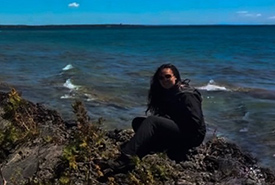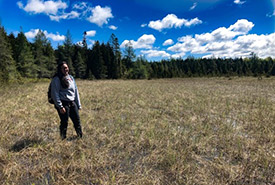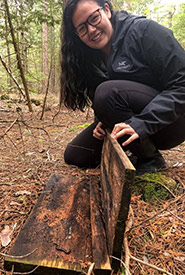Working in my traditional territory

Naomi Jones (Photo by NCC)
Let me introduce myself. My name is Naomi Jones, and I am from Chippewas of Nawash Unceded First Nation, also known as Neyaahsiinigmiing. It is a First Nations reserve on the Saugeen Bruce Peninsula. I am very proud of where I come from, and I make sure to represent my community everywhere I go.
This summer I am working as a conservation technician for the Nature Conservancy of Canada (NCC), out of their Saugeen Bruce Peninsula office. I have worked for NCC for three summers as a conservation technician. I started as an intern right out of high school and returned during summer breaks from Fleming College, where I studied fish and wildlife. Having learned skills while working for NCC before going to college gave me a good head start on some of the classes that I took, including wetland classification, field ornithology, habitat classification and wildlife observation. So, if you’re not sure whether you want to go into this field of work, volunteering with NCC could help you decide.
Related blog posts
Knowing how much of a positive impact I could have on the land of my traditional territory — from my summers spent with NCC — pushed me to work hard in college and take everything I learned there back home to keep the Saugeen Bruce Peninsula as natural as it is. I am now a graduate of the fish and wildlife program, and I was very lucky to get another technician position with NCC on the Saugeen Bruce Peninsula. I am able to use what I learned at school and at NCC to protect my home.

Having the opportunity to do conservation work in my traditional territory is something special. (Photo by NCC)
Having the opportunity to do conservation work in my traditional territory is something special. I grew up learning about my community’s culture, and knowing how connected to the land we are always interested me. That might be one of the reasons I like this job so much. I am able to connect with the land and know that it will be protected and stewarded for a very long time.
A lot of NCC properties on the Saugeen Bruce Peninsula protect so many important species and habitats that my community uses as resources for medicine, food, shelter and traditional cultural practices. It’s a great feeling knowing that these species and habitats are protected for future generations to see and learn about.

I am able to use what I learned at school and at NCC to protect my home. (Photo by NCC)
One of the species that NCC’s work protects is massasauga rattlesnake, Ontario’s only rattlesnake. This species is listed as threatened and is mainly found on the Saugeen Bruce Peninsula and eastern Georgian Bay. Small populations can be found in Wainfleet Bog and the Ojibway Prairie Complex. This snake is very important to my people, as a protector of the land.
Massasauga rattlesnake is a reminder to only take what you need. NCC-protected properties have many sensitive species, and massasauga rattlesnake can protect them from threats like poaching, the over-harvesting of plants and people hiking off of the trails.
Working as a conservation technician has been amazing. I can’t see myself doing anything else but conservation work. I have seen and learned so many incredible things over the last three summers, and I look forward to learning so much more in the years to come. I want to thank Bruce Power for helping make my internship possible by supporting the intern program on the Saugeen Bruce Peninsula.
The Conservation Internship Program is funded in part by the Government of Canada's Summer Work Experience program.


